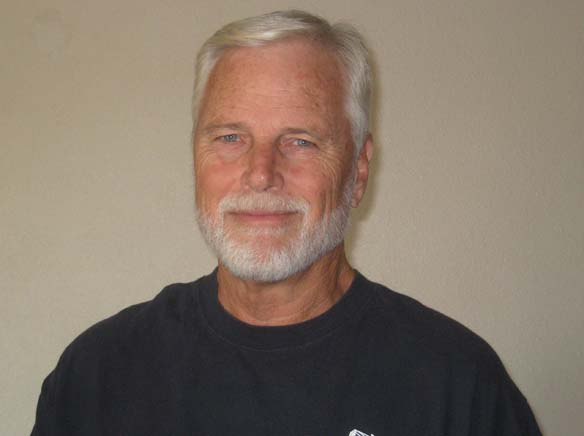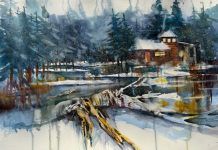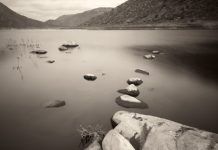While most other people are bedding down for the night, Dave Decker might just be winding up. He often leaves late from his La Mesa home to drive east on I-8. It’s not some bar or 24-hour diner he’s heading for; instead, he is driving up to the hills to look at stars.
While most other people are bedding down for the night, Dave Decker might just be winding up. He often leaves late from his La Mesa home to drive east on I-8. It’s not some bar or 24-hour diner he’s heading for; instead, he is driving up to the hills to look at stars.
Armed with binoculars, telescopes, star charts and maps, Decker makes regular stops along the Sunrise Highway and the Laguna Mountains to gaze at the heavenly bodies. This year is an astronomer’s dream for the Blood Moon lunar eclipse and more phenomena in the upcoming months.
Decker is the official East County Star Party Coordinator for the San Diego Astronomy Association, which he joined in 2009. One of the most recent events he put together was the very first Mt. Helix Star Party. Eleven SDAA members came to the event. Nearly 100 people came to peer through the 15 telescopes set up for viewing.
“The Mt Helix Park staff were wonderful, and hosted a well-planned event,” Decker said.
“It was a gorgeous night and the Space Station even slid through the sky near the end of our gazing,” said Mt. Helix Executive Director Tracey Stotz. “I’m delighted with the work that Decker did for us in planning this.”
Star Parties like the one at Mt. Helix is how new astronomers are born. Decker explained that currently, there is a great deal of general interest in astronomy, probably due to the research accomplished in the last 20 years and the way in which NASA and academic researchers have shared their goals, discoveries and new questions. That interest translates to requests from the public for “hands on” experiences.
Decker had always spent a great deal of time in the outdoors, camping and admiring the night sky. After he retired, he decided to get serious about studying astronomy.
“Perhaps it was my grandkids asking me about the constellations, and I wasn’t sure of their names. Or perhaps it was my old, lingering love of the physical sciences that finally came to the surface. The bottom line, I needed to go down that road in a serious way,” Decker said.
Becoming the Star Party Coordinator was the first stop on the road for Decker to learning and doing more serious astronomy. It is an intensive job of hosting over 100 parties per year, with only a few dozen volunteers.
“We are committed to all of San Diego County, and often our volunteers drive 100 or more miles for a two-hour event on a week day, after a day’s work. Therefore, last minute communication between volunteers and the host about weather, driving, and viewing conditions is critical,” he said.
All the driving, researching, hours volunteering are worth it to Decker who goes often goes out on his own to study the night skies.
“Under urban light-polluted skies, we are still able to show many bright celestial objects. Of note are the solar system objects of course. Venus, Mars, Jupiter, Saturn, the Sun and Moon, visible comets, meteors, International Space Station, Hubble Space Telescope,” he said
Dark skies are optimum to see much more. Even small telescopes will find many bright nebulas and some galaxies, open star clusters and globular star clusters. Binary stars can always be found as well.
“With decent optics we can view many Planetary Nebulas, galaxy clusters, and occasionally, a supernova,” he said.
To learn more about what the difference is between a nebula and a supernova, Decker recommends doing a little night research.
“You need to escape the marine layer, fog, and clouds. Find a dark place. Higher elevation is also an advantage. Wherever you go, park in a safe and legal place. We have done well in the mountains, Laguna and Cuyamaca,” he said. “Campgrounds are usually good when clear of security lighting. The Borrego Desert is wonderful as well, even though it is not high elevation. For quick observing sessions there are safe parking areas along Sunrise Highway with lots of room and no trees.”
Some of his personal favorite star-viewing spots include Sycamore Canyon and Tierra del Sol, both of which are open on SDAA nights.
“In the mountains, I like the Julian Starfest in August. This is held at the Menghini Winery. William Heise County Park and Cuyamaca State Park have good areas as well,” he said.
Decker suggests a pair of binoculars as the first equipment. Next, get a tripod to hold the binoculars still.
“By then, you will be wondering what all that stuff is and you will find a star chart, book, or astronomy app to help navigate. Okay, you’re hooked! Time to go shopping for expensive stuff,” he said.
Gazing at all the stars and planets can be a life-changing experience, even for children. Sometimes they can barely believe what they see.
Decker laughs remembering what one youngster proclaimed when he saw Saturn for the first time: “That’s not really Saturn, that’s a picture inside your telescope!”
For more information about San Diego Astronomy Association and East County Star Parties, go to www.sdaa.org.














